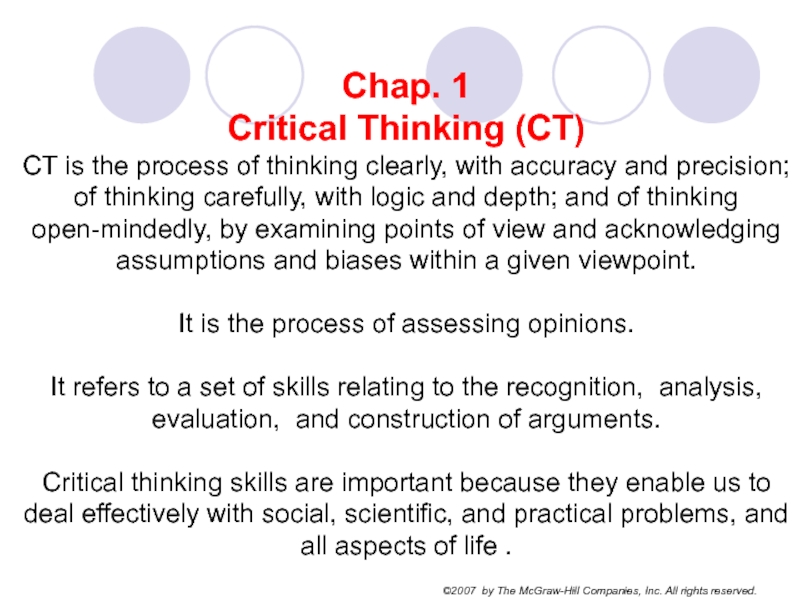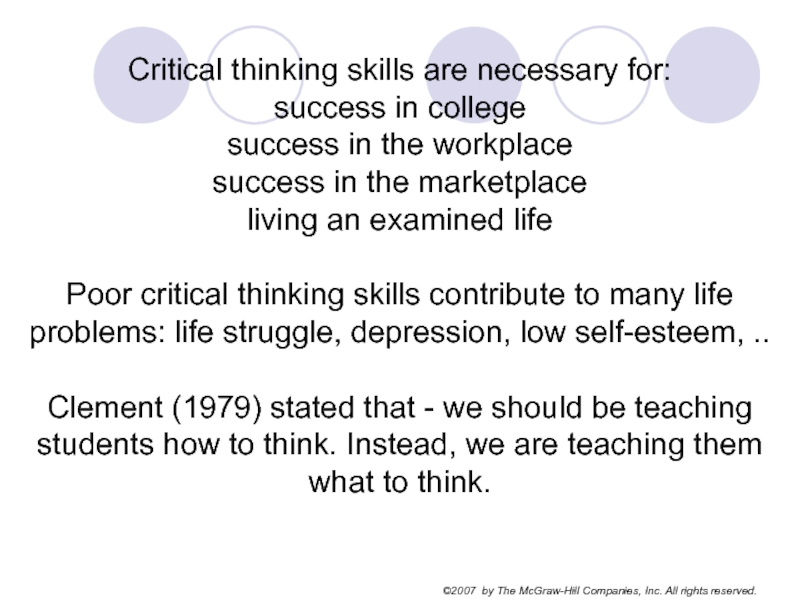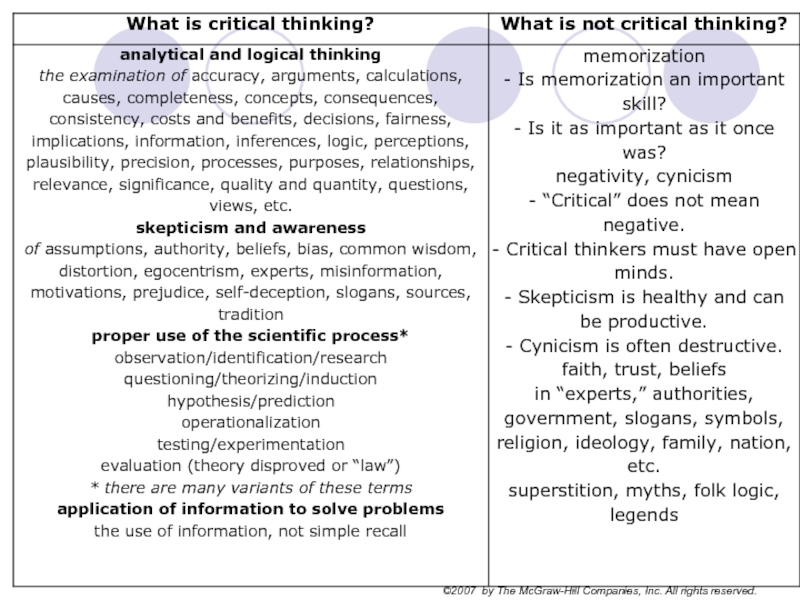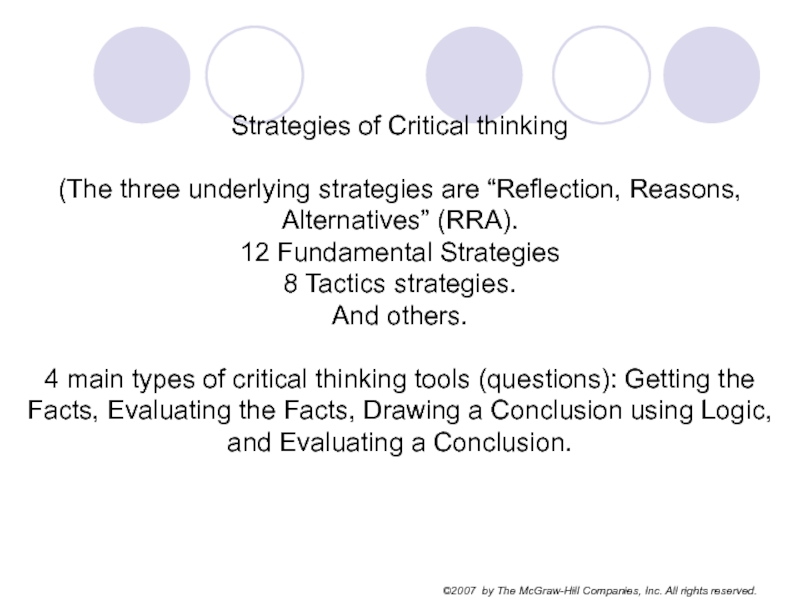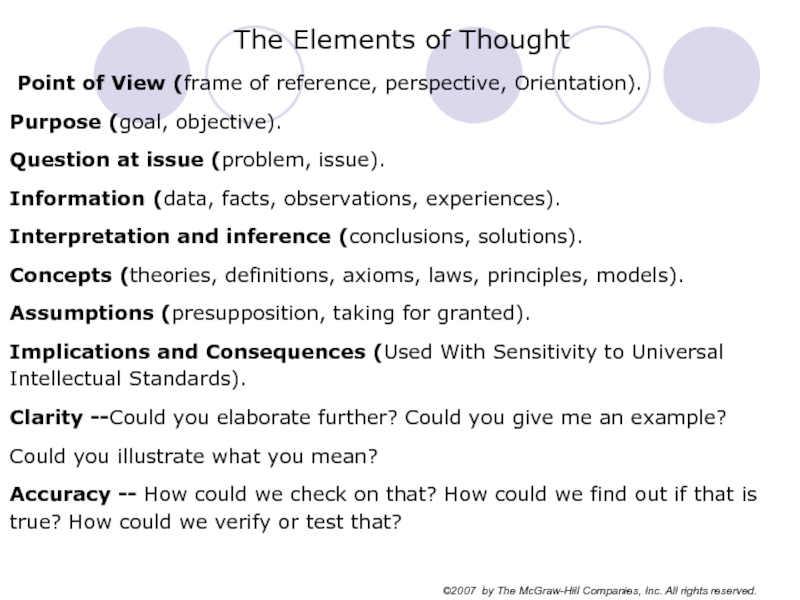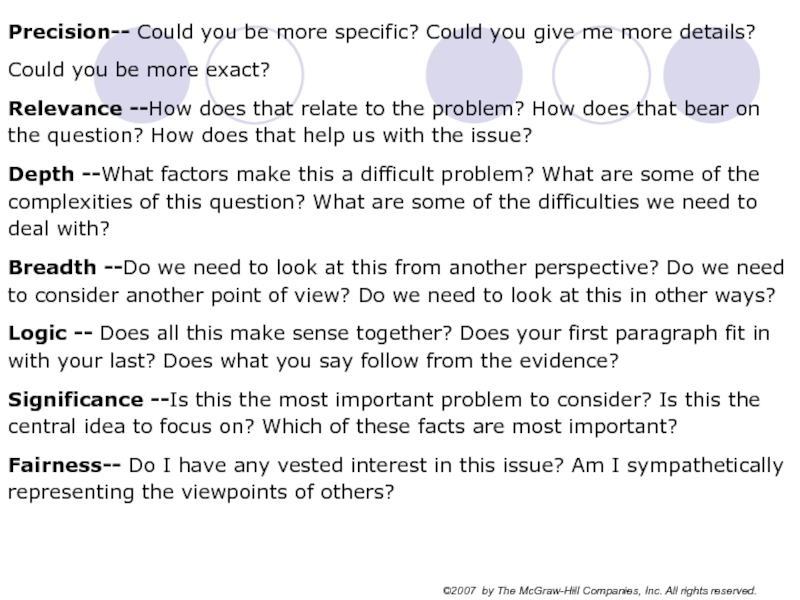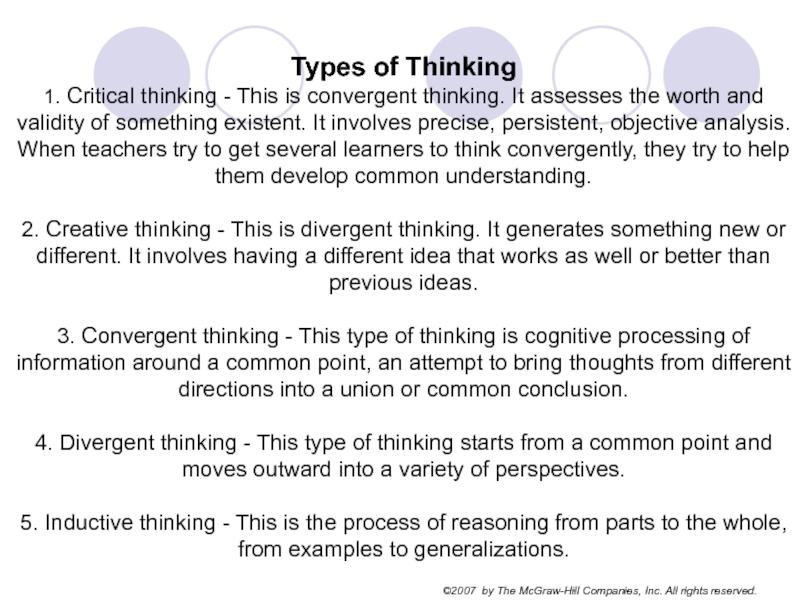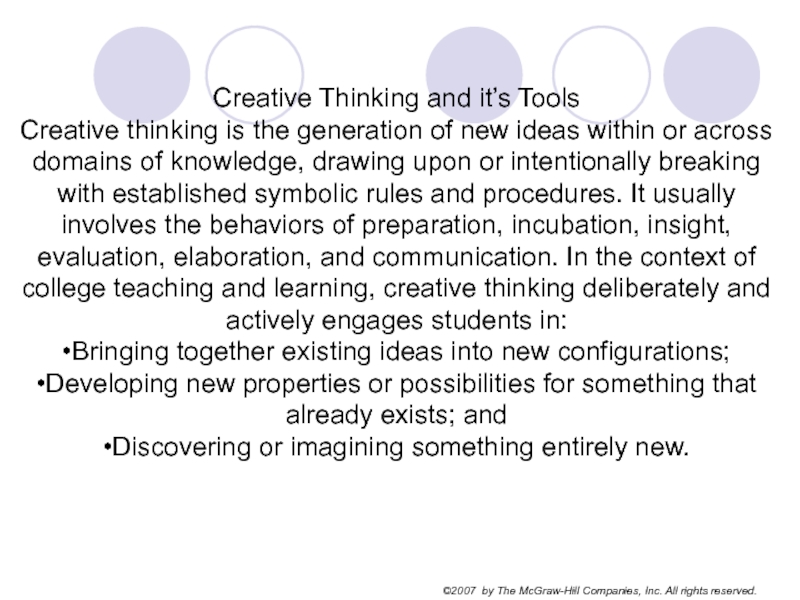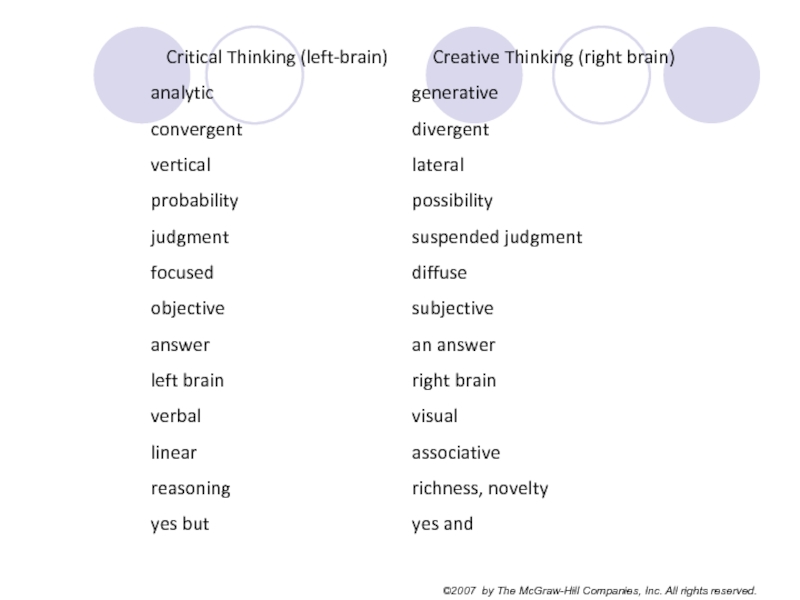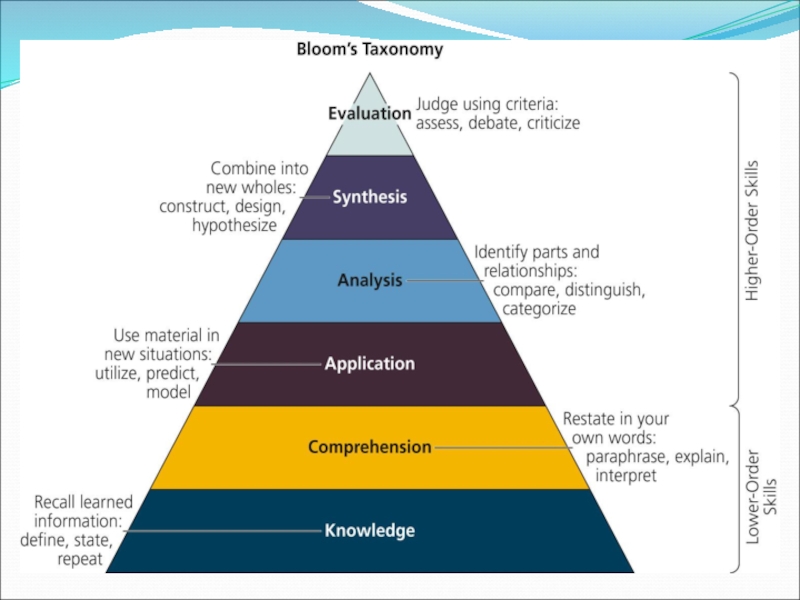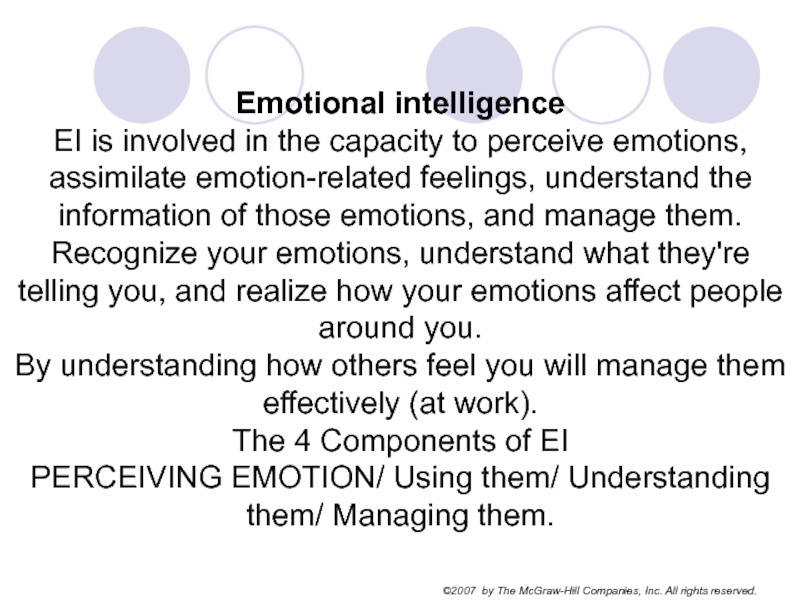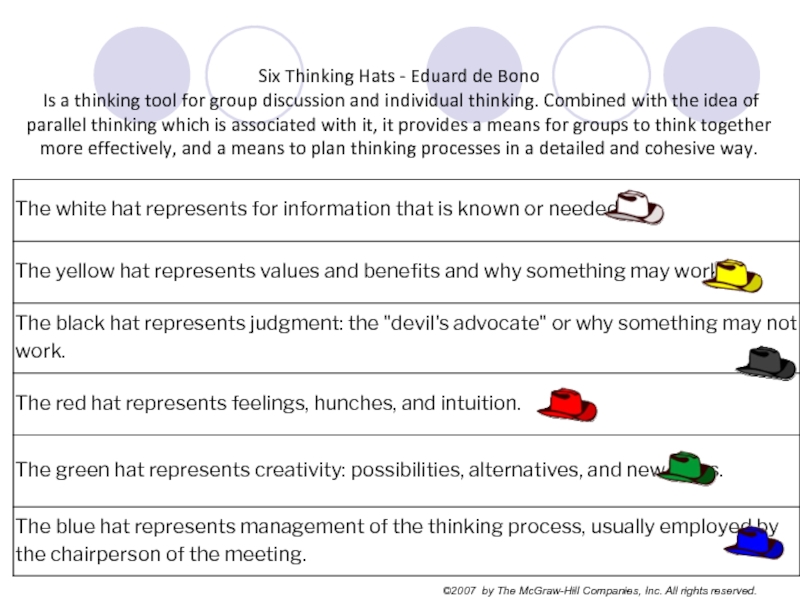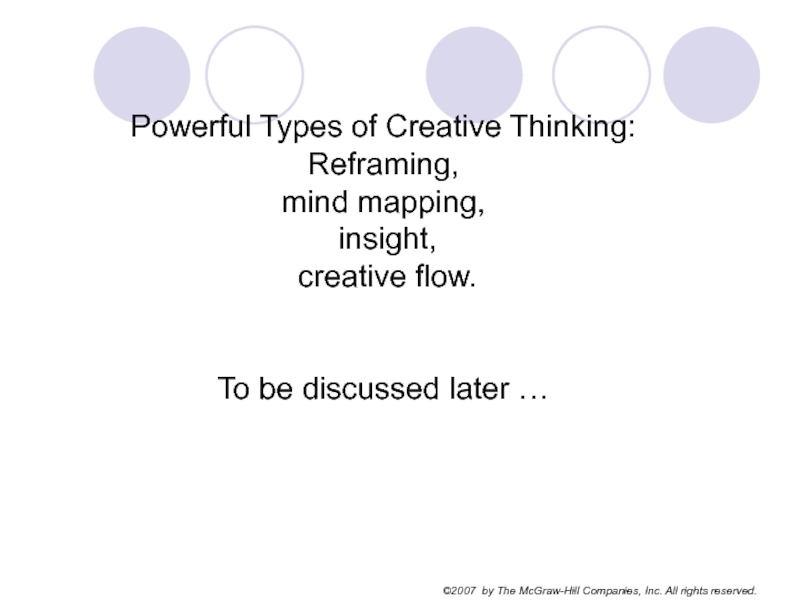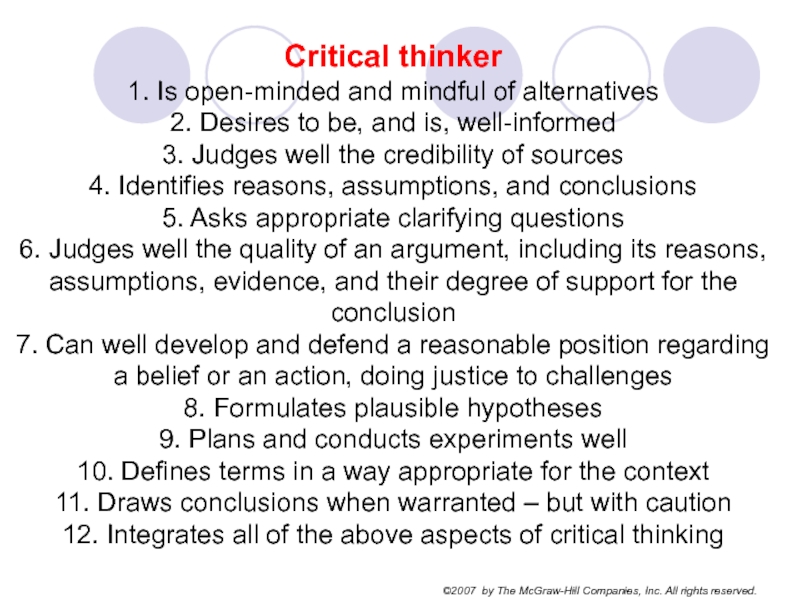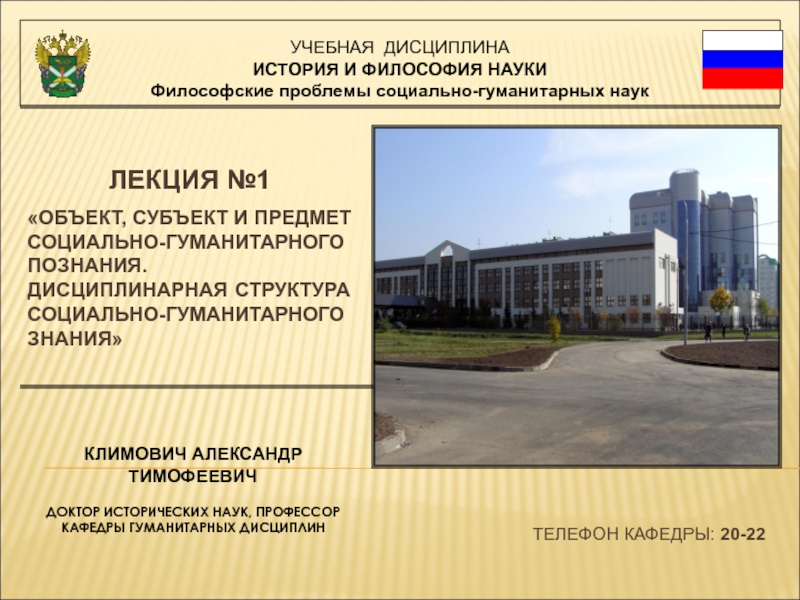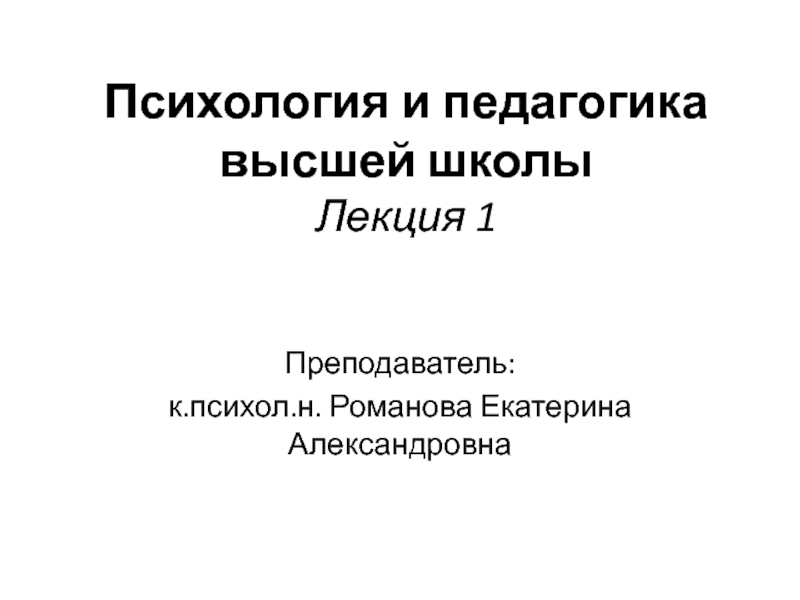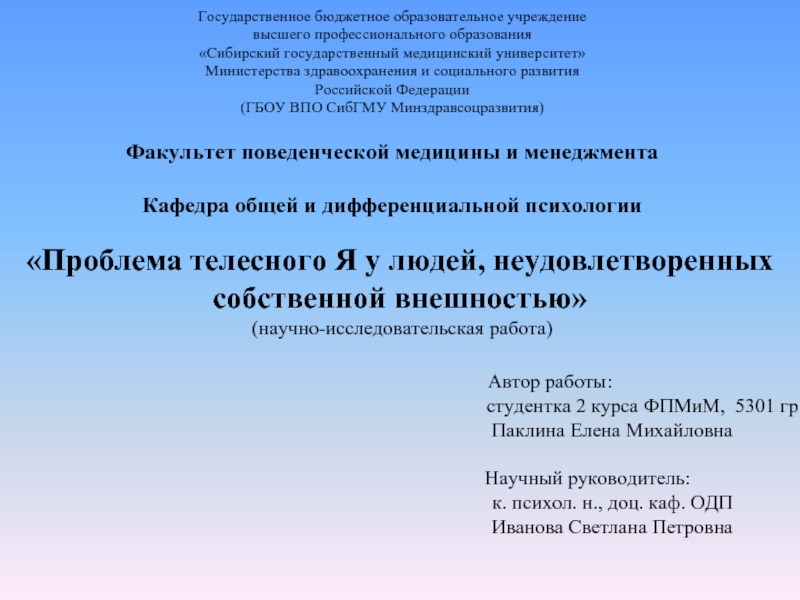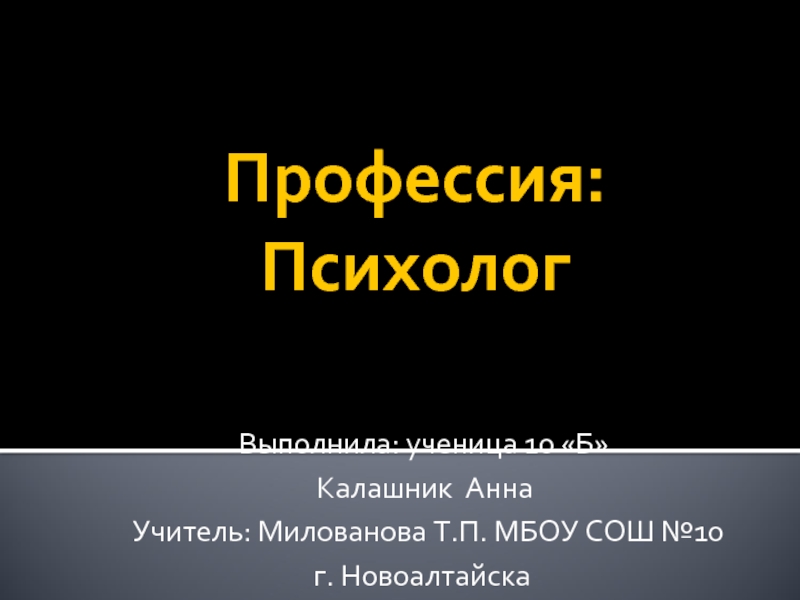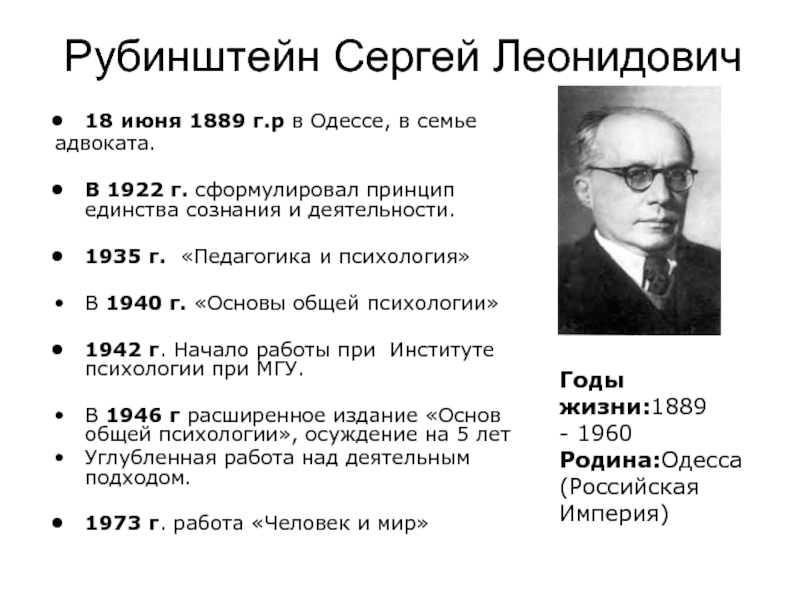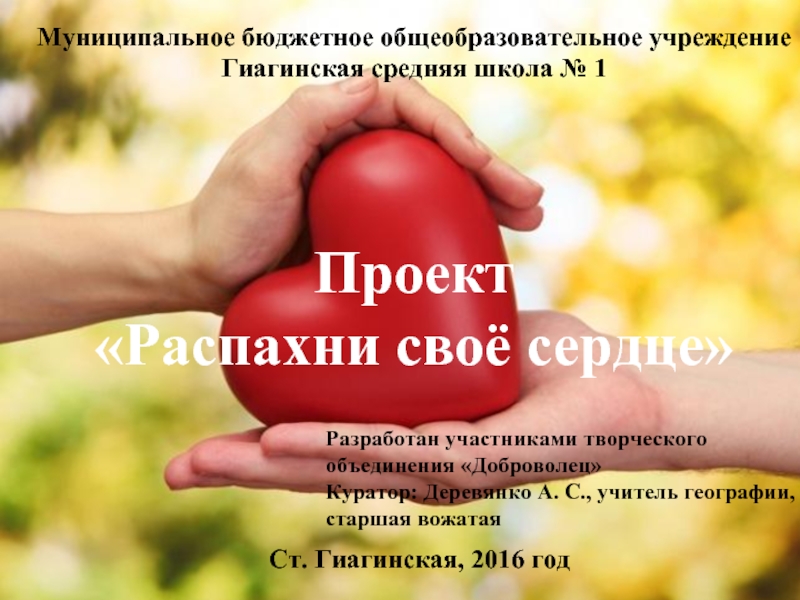(CT)
CT is the process of thinking clearly, with accuracy and precision; of thinking carefully, with logic and depth; and of thinking open-mindedly, by examining points of view and acknowledging assumptions and biases within a given viewpoint.
It is the process of assessing opinions.
It refers to a set of skills relating to the recognition, analysis, evaluation, and construction of arguments.
Critical thinking skills are important because they enable us to deal effectively with social, scientific, and practical problems, and all aspects of life .
- Главная
- Разное
- Дизайн
- Бизнес и предпринимательство
- Аналитика
- Образование
- Развлечения
- Красота и здоровье
- Финансы
- Государство
- Путешествия
- Спорт
- Недвижимость
- Армия
- Графика
- Культурология
- Еда и кулинария
- Лингвистика
- Английский язык
- Астрономия
- Алгебра
- Биология
- География
- Детские презентации
- Информатика
- История
- Литература
- Маркетинг
- Математика
- Медицина
- Менеджмент
- Музыка
- МХК
- Немецкий язык
- ОБЖ
- Обществознание
- Окружающий мир
- Педагогика
- Русский язык
- Технология
- Физика
- Философия
- Химия
- Шаблоны, картинки для презентаций
- Экология
- Экономика
- Юриспруденция
Critical Thinking презентация
Содержание
- 1. Critical Thinking
- 2. ©2007 by The McGraw-Hill Companies, Inc. All
- 3. ©2007 by The McGraw-Hill Companies, Inc. All rights reserved.
- 4. ©2007 by The McGraw-Hill Companies, Inc. All
- 5. ©2007 by The McGraw-Hill Companies, Inc. All
- 6. ©2007 by The McGraw-Hill Companies, Inc. All
- 7. ©2007 by The McGraw-Hill Companies, Inc. All
- 8. ©2007 by The McGraw-Hill Companies, Inc. All
- 9. ©2007 by The McGraw-Hill Companies, Inc. All rights reserved.
- 11. ©2007 by The McGraw-Hill Companies, Inc. All
- 12. ©2007 by The McGraw-Hill Companies, Inc. All
- 13. ©2007 by The McGraw-Hill Companies, Inc. All
- 14. ©2007 by The McGraw-Hill Companies, Inc. All
Слайд 2©2007 by The McGraw-Hill Companies, Inc. All rights reserved.
Critical thinking skills
are necessary for:
success in college
success in the workplace
success in the marketplace
living an examined life
Poor critical thinking skills contribute to many life problems: life struggle, depression, low self-esteem, ..
Clement (1979) stated that - we should be teaching students how to think. Instead, we are teaching them what to think.
success in college
success in the workplace
success in the marketplace
living an examined life
Poor critical thinking skills contribute to many life problems: life struggle, depression, low self-esteem, ..
Clement (1979) stated that - we should be teaching students how to think. Instead, we are teaching them what to think.
Слайд 4©2007 by The McGraw-Hill Companies, Inc. All rights reserved.
Strategies of Critical
thinking
(The three underlying strategies are “Reflection, Reasons, Alternatives” (RRA).
12 Fundamental Strategies
8 Tactics strategies.
And others.
4 main types of critical thinking tools (questions): Getting the Facts, Evaluating the Facts, Drawing a Conclusion using Logic, and Evaluating a Conclusion.
(The three underlying strategies are “Reflection, Reasons, Alternatives” (RRA).
12 Fundamental Strategies
8 Tactics strategies.
And others.
4 main types of critical thinking tools (questions): Getting the Facts, Evaluating the Facts, Drawing a Conclusion using Logic, and Evaluating a Conclusion.
Слайд 5©2007 by The McGraw-Hill Companies, Inc. All rights reserved.
The Elements of
Thought
Point of View (frame of reference, perspective, Orientation).
Purpose (goal, objective).
Question at issue (problem, issue).
Information (data, facts, observations, experiences).
Interpretation and inference (conclusions, solutions).
Concepts (theories, definitions, axioms, laws, principles, models).
Assumptions (presupposition, taking for granted).
Implications and Consequences (Used With Sensitivity to Universal Intellectual Standards).
Clarity --Could you elaborate further? Could you give me an example?
Could you illustrate what you mean?
Accuracy -- How could we check on that? How could we find out if that is true? How could we verify or test that?
Point of View (frame of reference, perspective, Orientation).
Purpose (goal, objective).
Question at issue (problem, issue).
Information (data, facts, observations, experiences).
Interpretation and inference (conclusions, solutions).
Concepts (theories, definitions, axioms, laws, principles, models).
Assumptions (presupposition, taking for granted).
Implications and Consequences (Used With Sensitivity to Universal Intellectual Standards).
Clarity --Could you elaborate further? Could you give me an example?
Could you illustrate what you mean?
Accuracy -- How could we check on that? How could we find out if that is true? How could we verify or test that?
Слайд 6©2007 by The McGraw-Hill Companies, Inc. All rights reserved.
Precision-- Could you
be more specific? Could you give me more details?
Could you be more exact?
Relevance --How does that relate to the problem? How does that bear on the question? How does that help us with the issue?
Depth --What factors make this a difficult problem? What are some of the complexities of this question? What are some of the difficulties we need to deal with?
Breadth --Do we need to look at this from another perspective? Do we need to consider another point of view? Do we need to look at this in other ways?
Logic -- Does all this make sense together? Does your first paragraph fit in with your last? Does what you say follow from the evidence?
Significance --Is this the most important problem to consider? Is this the central idea to focus on? Which of these facts are most important?
Fairness-- Do I have any vested interest in this issue? Am I sympathetically representing the viewpoints of others?
Could you be more exact?
Relevance --How does that relate to the problem? How does that bear on the question? How does that help us with the issue?
Depth --What factors make this a difficult problem? What are some of the complexities of this question? What are some of the difficulties we need to deal with?
Breadth --Do we need to look at this from another perspective? Do we need to consider another point of view? Do we need to look at this in other ways?
Logic -- Does all this make sense together? Does your first paragraph fit in with your last? Does what you say follow from the evidence?
Significance --Is this the most important problem to consider? Is this the central idea to focus on? Which of these facts are most important?
Fairness-- Do I have any vested interest in this issue? Am I sympathetically representing the viewpoints of others?
Слайд 7©2007 by The McGraw-Hill Companies, Inc. All rights reserved.
Types of Thinking
1.
Critical thinking - This is convergent thinking. It assesses the worth and validity of something existent. It involves precise, persistent, objective analysis. When teachers try to get several learners to think convergently, they try to help them develop common understanding.
2. Creative thinking - This is divergent thinking. It generates something new or different. It involves having a different idea that works as well or better than previous ideas.
3. Convergent thinking - This type of thinking is cognitive processing of information around a common point, an attempt to bring thoughts from different directions into a union or common conclusion.
4. Divergent thinking - This type of thinking starts from a common point and moves outward into a variety of perspectives.
5. Inductive thinking - This is the process of reasoning from parts to the whole, from examples to generalizations.
2. Creative thinking - This is divergent thinking. It generates something new or different. It involves having a different idea that works as well or better than previous ideas.
3. Convergent thinking - This type of thinking is cognitive processing of information around a common point, an attempt to bring thoughts from different directions into a union or common conclusion.
4. Divergent thinking - This type of thinking starts from a common point and moves outward into a variety of perspectives.
5. Inductive thinking - This is the process of reasoning from parts to the whole, from examples to generalizations.
Слайд 8©2007 by The McGraw-Hill Companies, Inc. All rights reserved.
Creative Thinking and
it’s Tools
Creative thinking is the generation of new ideas within or across domains of knowledge, drawing upon or intentionally breaking with established symbolic rules and procedures. It usually involves the behaviors of preparation, incubation, insight, evaluation, elaboration, and communication. In the context of college teaching and learning, creative thinking deliberately and actively engages students in:
•Bringing together existing ideas into new configurations;
•Developing new properties or possibilities for something that already exists; and
•Discovering or imagining something entirely new.
Creative thinking is the generation of new ideas within or across domains of knowledge, drawing upon or intentionally breaking with established symbolic rules and procedures. It usually involves the behaviors of preparation, incubation, insight, evaluation, elaboration, and communication. In the context of college teaching and learning, creative thinking deliberately and actively engages students in:
•Bringing together existing ideas into new configurations;
•Developing new properties or possibilities for something that already exists; and
•Discovering or imagining something entirely new.
Слайд 11©2007 by The McGraw-Hill Companies, Inc. All rights reserved.
Emotional intelligence
EI is
involved in the capacity to perceive emotions, assimilate emotion-related feelings, understand the information of those emotions, and manage them.
Recognize your emotions, understand what they're telling you, and realize how your emotions affect people around you.
By understanding how others feel you will manage them effectively (at work).
The 4 Components of EI
PERCEIVING EMOTION/ Using them/ Understanding them/ Managing them.
Recognize your emotions, understand what they're telling you, and realize how your emotions affect people around you.
By understanding how others feel you will manage them effectively (at work).
The 4 Components of EI
PERCEIVING EMOTION/ Using them/ Understanding them/ Managing them.
Слайд 12©2007 by The McGraw-Hill Companies, Inc. All rights reserved.
Six Thinking Hats
- Eduard de Bono
Is a thinking tool for group discussion and individual thinking. Combined with the idea of parallel thinking which is associated with it, it provides a means for groups to think together more effectively, and a means to plan thinking processes in a detailed and cohesive way.
Is a thinking tool for group discussion and individual thinking. Combined with the idea of parallel thinking which is associated with it, it provides a means for groups to think together more effectively, and a means to plan thinking processes in a detailed and cohesive way.
Слайд 13©2007 by The McGraw-Hill Companies, Inc. All rights reserved.
Powerful Types of
Creative Thinking:
Reframing,
mind mapping,
insight,
creative flow.
To be discussed later …
Reframing,
mind mapping,
insight,
creative flow.
To be discussed later …
Слайд 14©2007 by The McGraw-Hill Companies, Inc. All rights reserved.
Critical thinker
1. Is
open-minded and mindful of alternatives
2. Desires to be, and is, well-informed
3. Judges well the credibility of sources
4. Identifies reasons, assumptions, and conclusions
5. Asks appropriate clarifying questions
6. Judges well the quality of an argument, including its reasons, assumptions, evidence, and their degree of support for the conclusion
7. Can well develop and defend a reasonable position regarding a belief or an action, doing justice to challenges
8. Formulates plausible hypotheses
9. Plans and conducts experiments well
10. Defines terms in a way appropriate for the context
11. Draws conclusions when warranted – but with caution
12. Integrates all of the above aspects of critical thinking
